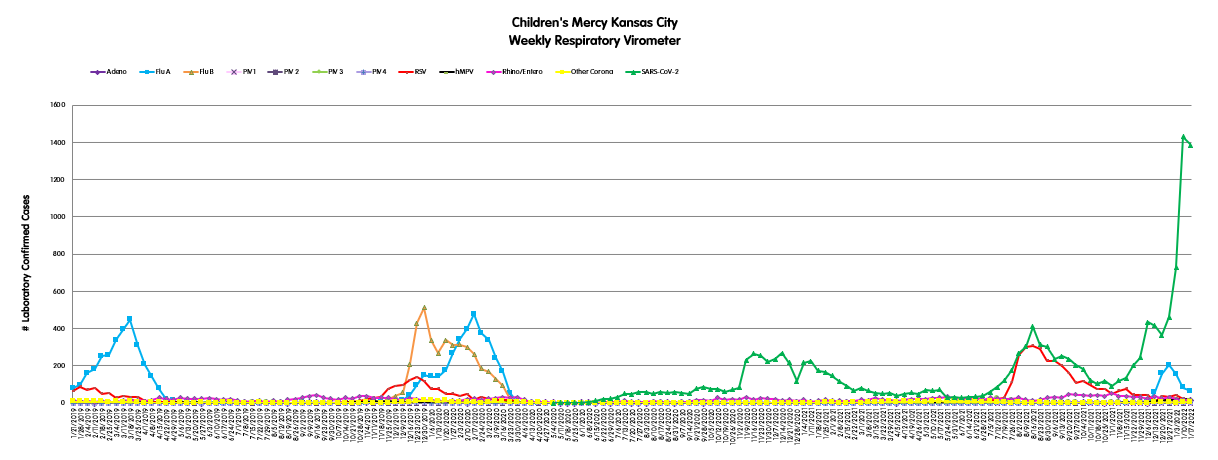Outbreaks, Alerts and Hot Topics
January 2022
Recent Changes on the Definition of Fully Vaccinated and Updated Quarantine and Isolation Guidelines from the CDC

Column Editor: Angela Myers, MD, MPH | Director, Division of Infectious Diseases | Professor of Pediatrics, UMKC School of Medicine | Medical Editor, The Link Newsletter
Just when you think you have it all down, the Centers for Disease Control and Prevention (CDC) makes multiple changes to definitions and quarantine and isolation recommendations that make your head spin. At least that’s how I felt when I read them. So, let’s go through the recent changes and see how they apply to pediatrics.
First, the definition of fully vaccinated.1
1. Having completed a primary series of Pfizer or Moderna vaccine at least two weeks ago,
OR
2. Having completed a primary series of Johnson & Johnson vaccine more than two months ago.
Additionally, a person is considered boosted and up-to-date right after receiving their booster dose at least five months after their last dose of either of the mRNA vaccines or at least two months after their Johnson & Johnson vaccine.2
Approximately 62 million Americans had received a booster dose as of the week of Christmas, representing 19% of the population and about one-third of those who had been fully vaccinated previously.3 The CDC recently extended eligibility of Pfizer boosters to 12- to 15-year-olds, and booster doses are now recommended for everyone 12 years and older.
The good news is that early evidence appears to show that Omicron has a shorter incubation period (three days vs. four to five with previous strains) and confers less severe infection compared to Delta.4 This variant replicates more quickly than the Alpha variant and the original strain and thus peaks faster in viral load. Thus, we may see a faster peak in the community than we have with previous strains, and while we are seeing more cases in children, we will hopefully not experience a higher proportion with severe disease. At Children’s Mercy, we have seen a rapid rise in COVID-19 cases to >1,400 last week, which is the highest number of cases we have seen in one week since the pandemic began. We should also note that we have continued to see influenza cases over the past two weeks. (Figure 1) We have also noticed a shift in the predominant age group of positive COVID-19 cases to 2- to 6-year-olds. (Figure 2)
This information leads us to the new isolation (COVID-19 positive) and quarantine (COVID-19 exposed) guidelines published by the CDC on Dec. 27, 2021.1
1. People infected with COVID-19 should isolate for five days. They may end isolation if their symptoms are resolving or resolved at the five-day mark and may transition to wearing a well-fitted mask for the next five days.
2. Exposed people, defined as ≥15 minutes over a 24-hour period within 6 feet with someone who is positive for COVID-19 should:
a. quarantine for five days, followed by wearing a well-fitted mask for an additional five days if they don’t meet the definition of fully vaccinated and remain asymptomatic,
OR
b. if fully vaccinated or don’t meet the definition of fully vaccinated and cannot quarantine, they should wear a well-fitting mask for 10 days provided they remain asymptomatic,
AND
c. all should ideally be tested for SARS-CoV-2 five days after exposure.
These new guidelines take into account the shorter incubation period mentioned previously. The guidelines are also based on emerging evidence that vaccinated people shed virus for a shorter period of time compared to unvaccinated individuals.5,6 Again, what does this mean for children? Children who are old enough and able to mask should follow the updated CDC guidance. Some schools and school districts have instituted test-to-stay (TTS) programs, which allow children to go to school with repeated testing and mask wearing after exposure instead of quarantining for five days at home. These programs meet the CDC guidance.
Data show that TTS programs work. Only 16 children out of 1,035 (1.5%) contacts became infected after masked exposure to a positive case at school or a school-based activity (inclusion criteria for the TTS program).7 There was no further spread from these 16 cases. Another study that compared schools that adopted TTS to those that did not in Los Angeles County showed no difference in the secondary attack rate of infection 0.7% vs. 1.3% in schools that did or did not implement TTS respectively.8 Tertiary transmission was not identified in this observational study either. That said, these schools also implemented enhanced ventilation with HEPA filtration, and these additional measures are likely part of the reason for the low transmission at these schools.9 Children who are too young to mask or who are unable to wear a mask should continue to isolate or quarantine at home for 10 days after infection or exposure.
Figure 1. Children’s Mercy Weekly Respiratory Virometer (courtesy of Dr. Selvarangan)
Click here to view a larger version of the graph.
Figure 2. Weekly COVID-19 positive volume by age (courtesy of Dr. Weddle)
Click here to view a larger version of the graph.
References:
- https://www.cdc.gov/media/releases/2021/s1227-isolation-quarantine-guidance.html
- https://www.cdc.gov/coronavirus/2019-ncov/vaccines/stay-up-to-date.html
- https://www.cnbc.com/2021/12/22/us-covid-cases-booster-shots-on-the-rise-as-country-nears-christmas.html
- Jansen L, Tegomoh B, Lange K, et al. Investigation of a SARS-CoV-2 B.1.1.529 (Omicron) variant cluster—Nebraska, November-December 2021. MMWR Morb Mortal Wkly Rep. Published online December 28, 2021. https://www.cdc.gov/mmwr/volumes/70/wr/mm705152e3.htm
- Adamson PC, Pfeffer MA, Arboleda VA, et al. Lower severe acute respiratory syndrome coronavirus 2 viral shedding following coronavirus disease 2019 vaccination among healthcare workers in Los Angeles, California. Open Forum Infect Dis. 2021;8(11):1-4.
- Chia PY, Xiang SW, Chiew CJ, et al. Virological and serological kinetics of SARS-CoV-2 Delta variant vaccine-breakthrough infections: a multi-center cohort study. medRxiv. Preprint posted online July 31, 2021. https://www.medrxiv.org/content/10.1101/2021.07.28.21261295v1.full.pdf
- Nemoto N, Dhillon S, Fink S, et al. Evaluation of test to stay strategy on secondary and tertiary transmission of SARS-CoV-2 in K-12 schools—Lake County, Illinois, August 9-October 29, 2021. MMWR Morb Mortal Wkly Rep. 2021;70:1778-1781. doi:http://dx.doi.org/10.15585/mmwr.mm705152e2
- Harris-McCoy K, Lee VC, Munna C, Kim AA. Evaluation of a test to stay strategy in transitional kindergarten through grade 12 schools—Los Angeles County, California, August 16-October 31, 2021. MMWR Morb Mortal Wkly Rep. 2021;70:1773-1777. doi:http://dx.doi.org/10.15585/mmwr.mm705152e1
- https://www.cdph.ca.gov/Programs/CCDPHP/DEODC/EHLB/IAQ/Pages/Airborne-Diseases.aspx


